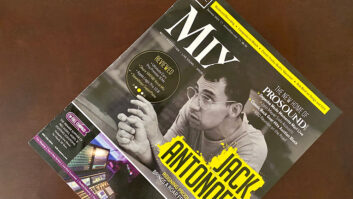The best thing about being editor of Mix is that I get to meet such a wide variety of creative, smart, interesting, technical, curious, articulate, well-rounded, passionate and simply fascinating people—from all types of backgrounds, from all walks of life. There are mad scientists who know more about electricity, physics or acoustics than anyone I will likely ever meet, and there are high school dropouts who have a creative bent for mixing chart-topping music. They all have a story.
advertisement
I got my degree in journalism and fell into pro audio. I didn’t live the passion that so fuels our industry. I didn’t tinker with my radio when I was 6, didn’t pick up a guitar at 13, didn’t memorize liner notes or follow producers, didn’t work in a hi-fi store, didn’t make beats. But I’ve always loved music, and I can recognize passion when I see it. The recording industry is overflowing with passion. What makes that passion unique, at least in my observations, is that it is rooted in a blend of the scientific and the emotional, the left-brain/right-brain, the creative and the technical.
Soon after being hired by Mix, I came in regular contact with Stephen St. Croix, a tremendous columnist who became a friend over the years before his passing in 2006. He remains one of the truly brilliant men I’ve met in my life, with a mind that could grasp and expand on concepts and designs, build the Marshall Time Modulator, become an expert in forensic audio, play synth with Stevie Wonder, produce Swedish rock bands, find peace when petting a cat, and mix the first VHS remastered version of The Wizard of Oz. Or George Massenburg, inventor of the parametric EQ, studio owner, manufacturer and engineer for Earth, Wind & Fire, Little Feat and countless others. Or the late Bruce Jackson, with a legacy at Apogee and Lake, and with Barbra Streisand. Les Paul, Bill Putnam, Tom Dowd…there are so many more. These are exceptional minds in any field, a rare confluence in the corpus callosum, where left-brain and right-brain wrestle for dominance.
But I’ve found in my 25 years here at Mix that it’s that way throughout professional audio. Admittedly, it’s not always on the same level as those just mentioned, but the common thread is a synergy between technical and creative aptitude. Sometimes it leans to the left, and you find some individual building a boutique preamp in a garage; sometimes it leans right and you have a 20-year-old producer with a magic touch. It makes sense that these types of minds are drawn to music.
I’ve been thinking a lot about the technical and creative this past month because of two interviews in this issue. The first was with The Scientist, John Meyer of Meyer Sound. John has a genius mind, a scientific mind. He solves problems from an engineer’s point of view. “The danger about working with science and intuition,” he says, “is that scientists don’t believe in intuition.” He experiments. When he started his company in 1979, the first couple of years were spent building a measurement tool so that he would know how to measure his achievements in loudspeaker system design. He also loves the symphony, theater, all types of performance, and he started out working with the Grateful Dead, joan Baez, Steve Miller Band, Metallica, Herbie Hancock and many other artists. He knows music.
The second interview was with this month’s cover boy, Dave Tozer, a musician/songwriter/arranger/producer/engineer who lives the spirit, vibe, scene, creation, energy, voodoo of music. His story is one long stream of musical immersion, with influences form all genres and a penchant for rock and hip-hop. He lives a New York music and recording life, and it’s all about creation. He also interned at a Philadelphia studio when he was 19, is fluent in old-school recording techniques and a master of Logic, and he recorded and mixed John Legend’s recent Grammy-nominated Love In The Future. So he knows tech. He knows audio.
Meyer’s and Tozer’s stories, on any and all levels, are repeated over and over in all aspects of the professional recording industry. In all regions of the country. In schools, in manufacturing facilities, and in sales offices. Onstage, in the studio or broadcast to the world. It’s the left and right brain bringing out the best of the creative and the technical. It sure keeps my life interesting, as I’m sure it does all of yours.
Tom Kenny
Editor
PS: This month’s cover represents something of a departure from the typical Mix style, or rather, a look back. In an early phone call with Dave Tozer, he expressed his appreciation for our March 2010 Lenny Kravitz cover. He liked the artistic sense and asked if he and the photographer, Michael Vecchio, could play with the image and select their own fonts.







